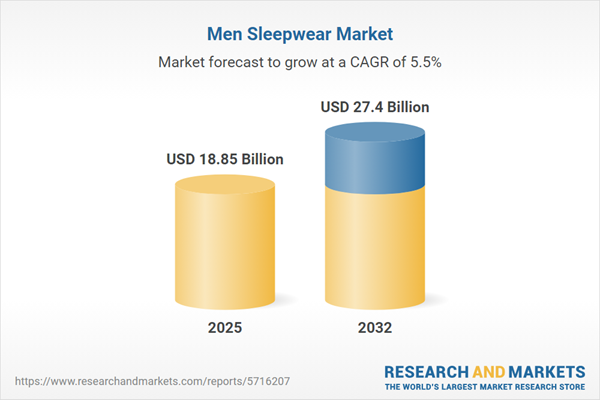Speak directly to the analyst to clarify any post sales queries you may have.
The men's sleepwear market is advancing rapidly, shaped by shifting consumer expectations, digital transformation, and sustainability mandates. Brands are innovating to meet rising demand for comfort, performance, and ethical production, driving strategic change across the industry.
Market Snapshot: Growth and Emerging Influences in the Men's Sleepwear Market
The men's sleepwear market grew from USD 17.91 billion in 2024 to USD 18.85 billion in 2025 and is expected to maintain a robust growth trajectory at a CAGR of 5.46%, reaching USD 27.40 billion by 2032. This dynamic sector is propelled by evolving consumer lifestyles, strong interest in functional and aesthetic sleepwear, and new value creation opportunities that blend performance, style, and sustainability.
Scope & Segmentation: Comprehensive Coverage of Men's Sleepwear Trends
- Product Types: Boxer shorts, lounge sets (long and short sleeves), nightshirts, nightwear thermals, pajamas (one-piece and two-piece sets), robes (hooded, short, and zipped).
- Material Categories: Bamboo, cotton (brushed, muslin, poplin), flannel, linen, polyester, and silk (pure and blends).
- Fit Options: Regular, relaxed, and slim fit, each catering to various style and functional preferences.
- Seasonality: All-season, summer sleepwear, and winter sleepwear offerings ensure year-round relevance.
- Age Groups: Sleepwear lines designed for adults, seniors, and teenagers provide tailored sizing and styling.
- Distribution Channels: Offline (brand-owned, department, specialty stores) and online retailers (brand websites, eCommerce platforms) support diverse purchasing preferences.
- Geographic Regions: Americas (North America, Latin America), Europe, Middle East & Africa (including key Western, Eastern, and Middle Eastern markets), and Asia-Pacific (major economies in East, Southeast, and South Asia).
- Technology Integration: Virtual fitting, subscription models, smart textiles, and digital-driven personalization enhance the customer journey and product innovation.
Key Takeaways: Strategic Insights for Senior Leaders
- Consumer demand for eco-conscious and high-performance fabrics is prompting brand investment in sustainable sourcing and textile innovation.
- Digital channels are revolutionizing engagement, with virtual try-on tools and data-driven personalization reshaping direct-to-consumer relationships.
- Sleepwear preferences vary notably by region; brands must localize design, price, and messaging to resonate across markets from North America to Asia-Pacific.
- Emerging partnerships, including technology collaborations and sustainability consortia, are influencing product pipelines and competitive benchmarks.
- Omnichannel strategies that integrate online and in-store experiences drive loyalty and enable agile product adaptation in response to real-time feedback.
Tariff Impact: Navigating Regulatory Complexity
Recent tariff adjustments in the United States have led to elevated production costs for textile imports, compelling manufacturers to diversify sourcing and reconsider production locations. Strategies such as vertical integration and near-shoring in tariff-advantaged regions help offset supply chain risk, although they may introduce new operational demands. This evolving regulatory environment reinforces the importance of agile scenario planning to maintain competitiveness amid global trade shifts.
Methodology & Data Sources
This report leverages a hybrid research approach, including interviews with senior supply chain and brand executives, review of trade publications and regulatory filings, and triangulation of multiple data sources. Advanced statistical tools and ongoing peer review contribute to reliability and actionable intelligence for strategic leaders.
Why This Report Matters
- Equips executive decision-makers with actionable insights grounded in primary research and thorough segmentation analysis.
- Enables forward planning in response to regulatory shifts, digital disruption, and evolving consumer values across global and regional markets.
Conclusion
Senior leaders can leverage this in-depth analysis to inform decisions on sustainable sourcing, digital engagement, and global expansion. By aligning with both market trends and regulatory changes, organizations can enhance resilience and capture emerging opportunities in the evolving men's sleepwear sector.
Additional Product Information:
- Purchase of this report includes 1 year online access with quarterly updates.
- This report can be updated on request. Please contact our Customer Experience team using the Ask a Question widget on our website.
Table of Contents
3. Executive Summary
4. Market Overview
7. Cumulative Impact of Artificial Intelligence 2025
Companies Mentioned
The companies profiled in this Men's Sleepwear market report include:- AIMER HONGKONG LIMITED.
- American Eagle Outfitters, Inc.
- Contare Pty Ltd.
- Cozy Earth
- David Jones Pty Ltd.
- Dolce & Gabbana
- Eberjey
- Everlane, Inc.
- Grupo Massimo Dutti, S.A.
- Guccio Gucci S.p.A.
- H&M Group
- Hanesbrands Inc.
- Jockey International, Inc.
- Levi Strauss & Co.
- Living Brown Private Limited
- Muji by Ryohin Keikaku Co., Ltd.
- Nordstrom, Inc.
- Paul Smith Limited
- Perry Ellis International, Inc.
- PVH Corp.
- Ralph Lauren Europe Sàrl
- Rupa & Co. Ltd.
- Skims Body, Inc.
- Style Union
- The Gap, Inc.
- UNIQLO CO., LTD.
- Zalora by Jade EServices Malaysia Sdn. Bhd.
Table Information
| Report Attribute | Details |
|---|---|
| No. of Pages | 185 |
| Published | November 2025 |
| Forecast Period | 2025 - 2032 |
| Estimated Market Value ( USD | $ 18.85 Billion |
| Forecasted Market Value ( USD | $ 27.4 Billion |
| Compound Annual Growth Rate | 5.4% |
| Regions Covered | Global |
| No. of Companies Mentioned | 28 |









